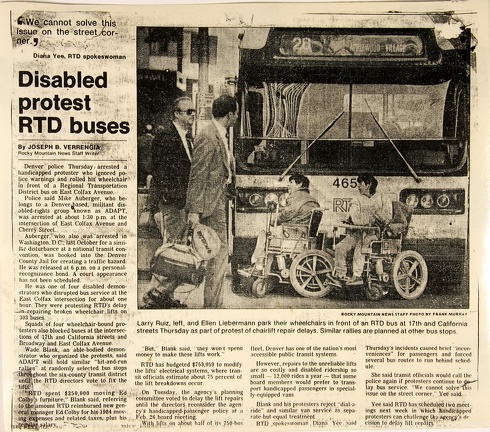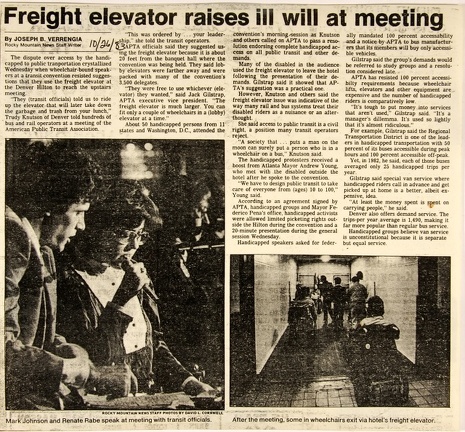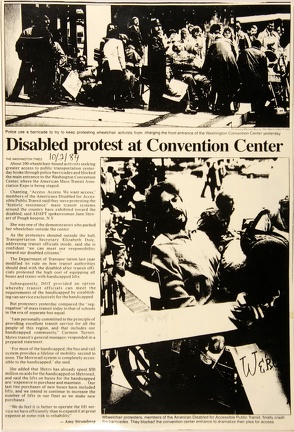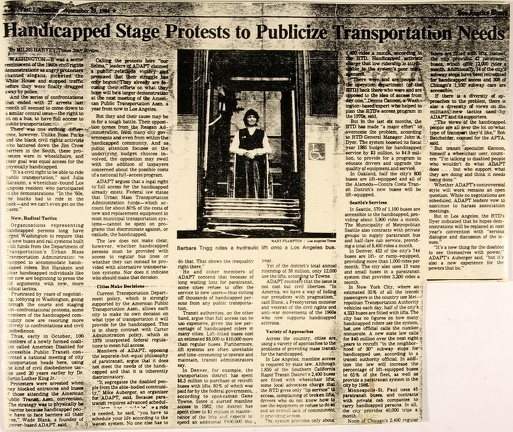- LingvoAfrikaans Argentina AzÉrbaycanca
á¥áá áá£áá Äesky Ãslenska
áá¶áá¶ááááá à¤à¥à¤à¤à¤£à¥ বাà¦à¦²à¦¾
தமிழ௠à²à²¨à³à²¨à²¡ ภาษาà¹à¸à¸¢
ä¸æ (ç¹é«) ä¸æ (é¦æ¸¯) Bahasa Indonesia
Brasil Brezhoneg CatalÃ
ç®ä½ä¸æ Dansk Deutsch
Dhivehi English English
English Español Esperanto
Estonian Finnish Français
Français Gaeilge Galego
Hrvatski Italiano Îλληνικά
íêµì´ LatvieÅ¡u Lëtzebuergesch
Lietuviu Magyar Malay
Nederlands Norwegian nynorsk Norwegian
Polski Português RomânÄ
Slovenšcina Slovensky Srpski
Svenska Türkçe Tiếng Viá»t
Ù¾Ø§Ø±Ø³Û æ¥æ¬èª ÐÑлгаÑÑки
ÐакедонÑки Ðонгол Ð ÑÑÑкий
СÑпÑки УкÑаÑнÑÑка ×¢×ר×ת
اÙعربÙØ© اÙعربÙØ©
Akceptejo / Fotaroj / Etikedoj separate but equal + wheelchair bound
+ wheelchair bound 4
4

 ADAPT (125)
ADAPT (125)
Rocky Mountain News 12/15/1985 Disabled Protest RTD Buses By Joseph B. Verrengia Rocky Mountain News Staff Writer Denver police Thursday, arrested a handicapped protestor who ignored police warnings and rolled his wheelchair in front of a Regional Transportation District bus on East Colfax Avenue. Police said Mike Auberger, who belongs to a Denver-based, militant disabled-rights group known as ADAPT, was arrested at about 1:30 p.m. at the intersection of East Colfax Avenue and Cherry Street. Auberger, who also was arrested in Washington, D.C. last October for a similar disturbance at a national transit convention, was booked into the Denver County Jail for creating a traffic hazard. He was released at 6 p.m. on a personal-recognizance bond. A court appearance has not been scheduled. He was one of four disabled demonstrators who disrupted bus service at the East Colfax intersection for about one hour. They were protesting RTD’s delay in repairing broken wheelchair lifts on 303 buses. Squads of four wheelchair-bound protestors also blocked buses at the intersections of the 17th and California streets and Broadway and East Colfax Avenue. Wade Blank, an able-bodied demonstrators who organized the protests, said ADAPT will hold similar “hit-and-run rallies” at randomly selected bus stops throughout the six-county transit district until the RTD directors vote to fix the lifts. "RTD spent $250,000 moving Ed Colby’s furniture,” Blank said, referring to the amount RTD reimbursed new general manager Ed Colby for his 1984 moving expenses and related taxes, plus his regular salary. “But,” Blank said, “they won’t spend money to make these lift s work.” RTD has budgeted $753,059 to modify the lifts’ electrical systems, where transit officials estimate about 75 percent of the lift breakdowns occur. On Tuesday, the agency’s planning committee voted to delay the lift repairs until the directors reconsider the agency’s handicapped-passenger policy at a Feb. 26 board meeting. With lifts on about half of its 750 bus fleet, Denver has one of the nation’s most accessible public transit systems. However repairs to the unreliable lifts are so costly and disabled ridership so small – 12,000 rides a year – that some board members would prefer to transport handicapped passengers in specially-equipped vans. Blank and his protestors reject “dial-a-ride” and similar van service as separate–but-equal treatment. RTD spokeswoman Diana Yee said Thursday’s incidents caused brief “inconveniences” for passengers and forced several bus routes to run behind schedule. She said transit officials would call the police again if protestors continue to do lay bus service. “We cannot solve this issue on the street corner,” Yee said. Yee said RTD has scheduled two meetings next week in which handicapped protestors can challenge the agency’s decision to delay lift repairs. Photo by staff Frank Murray [in the Top Right Corner]: Two men in suit coats and ties cross the street in from of a city bus that is being blocked by two people in power wheelchairs. A man [Larry Ruiz] and a woman [Ellen Liebermann] sit in their power wheelchairs in front of the middle of an RTD bus, #28 headed to Applewood Village, blocking it from going forward. Caption: Larry Ruiz, left, and Ellen Liebermann park their wheelchairs in front of an RTD bus at 17th and California streets Thursday as part of protest of chairlift repair delays. Similar rallies are planned at other bus stops. Highlighted quote on top left of page: “We cannot solve this problem on the street corner.”- Diana Yee, RTD spokeswoman ADAPT (169)
ADAPT (169)
Rocky Mountain News 10/26/83 Two PHOTOS (by Rocky Mountain News staff photographer David Cornwell). PHOTO 1: Close up of a man (Mark Johnson) and a woman (Renata Conrad aka Rabe) looking down at a paper, as if conferring. She is holding a microphone in her hand. Beside them sits another man. Caption reads: Mark Johnson and Renate Rabe speak at meeting with transit officials. PHOTO 2: Down a long institutional looking hallway a group of people in wheelchairs and people walking head away from the camera. caption reads: After the meeting, some in wheelchairs exit via hotel's freight elevator. [Headline] Freight elevator raises ill will at meeting By JOSEPH B. VERRENGIA Rocky Mountain News Staff Writer The dispute over access by the handicapped to public transportation crystallized Wednesday when wheelchair-bound speakers at a transit convention resisted suggestions that they use the freight elevator at the Denver Hilton to reach the upstairs meeting. “They (transit officials) told us to ride up the elevator that will later take down the garbage and trash from your lunch," Trudy Knutson of Denver told hundreds of bus and rail operators at a meeting of the American Public Transit Association. "This was ordered by ... your leadership," she told the transit operators. APTA officials said they suggest using the freight elevator because it is about 20 feet from the banquet hall where the convention was being held. They said lobby elevators were farther away and were packed with many of the convention‘s 3.500 delegates. "They were free to use whichever (elevator) they wanted." said Jack Gilstrap, APTA executive vice president. “The freight elevator is much larger. You can fit only a couple of wheelchairs in a (lobby) elevator at a time." About 50 handicapped persons from ll states and Washington, D.C., attended the convention‘s morning session as Knutson and others called on APTA to pass a resolution endorsing complete handicapped access on all public transit and other demands. Many of the disabled in the audience used the freight elevator to leave the hotel following the presentation of their demands. Gilstrap said it showed that APTA's suggestion was a practical one. However, Knutson and others said the freight elevator issue was indicative of the way many rail and bus systems treat their disabled riders as a nuisance or an afterthought. She said access to public transit is a civil right, a position many transit operators reject. "A society that puts a man on the moon can surely put a person who is in a wheelchair on a bus," Knutson said. The handicapped protesters received a boost from Atlanta Mayor Andrew Young, who met with the disabled outside the hotel after he spoke to the convention. "We have to design public transit to take care of everyone from (ages) 10 to 100," Young said. According to an agreement signed by APTA, handicapped groups and Mayor Federico Pena‘s office, handicapped activists were allowed limited picketing rights outside the Hilton during the convention and a 20-minute presentation during the general session Wednesday. Handicapped speakers asked for federally mandated 100 percent accessibility and a notice by APTA to bus manufacturers that its members will buy only accessible vehicles. Gilstrap said the group's demands would be referred to study groups and a resolution considered late. APTA has resisted 100 percent accessibility requirement because wheelchair lifts, elevators and other equipment are expensive and the number of handicapped riders is comparatively low. "It's tough to put money into services that aren't used" Gilstrap said. “It's a manager's dilemma. It‘s used so lightly that it‘s almost ridiculous." For example, Gilstrap said the Regional Transportation District is one of the leaders in handicapped transportation with 50 percent of its buses accessible during peak hours and 100 percent accessible off-peak. Yet, in 1982, he said, each of those buses averaged only 25 handicapped trips per year. Gilstrap said special van service where handicapped riders call in advance and get picked up at home is a better, albeit expensive, idea. "At least the money spent is spent on carrying people,“ he said. Denver also offers demand service. The trips-per year average is 1,490, making it far more popular than regular bus service. Handicapped groups believe van service is unconstitutional because it is separate but equal service. ADAPT (157)
ADAPT (157)
The Washington Times 10-2-84 PHOTO 1 (Photos by Richard Kozas, The Washington Times): A mass of ADAPT protesters block the entire sidewalk. Some are in wheelchairs, some are on the ground. In front of them are five or six police officers. Behind the protesters is a mass of people standing. (Among the protesters on the line: Mike Auberger, George Cooper?, Mickey Rodriguez.) Caption reads: Police use a barricade to try to keep protesting wheelchair activists from charging the front entrance of the Washington Convention Center yesterday. PHOTO 2: A protester (Tom Pugh), his face filled with passion, is up against a barricade. Someone appears to be lying across his lap. Behind him you can see other protesters (including George Cooper?) Caption reads: Wheelchair protesters, members of the American Disabled for Accessible Public Transit, finally crash the barricades. They blocked the convention center entrance to dramatize their plea tor access. [Headline] Disabled protest at Convention Center The Washington Times About 100 wheelchair-bound activists seeking greater access to public transportation yesterday broke through police barricades and blocked the main entrance to the Washington Convention Center, where the American Mass Transit Association Expo is being staged. Chanting, “Access. Access. We want access," members of the Americans Disabled for Accessible Public Transit said they were protesting the "historic resistance" mass transit systems around the country have exhibited toward the disabled, said ADAPT spokeswoman Jane Stewart of Poughkeepsie. N.Y. She was one of the demonstrators who parked her wheelchair outside the center. As the protesters shouted outside the hall, Transportation Secretary Elizabeth Dole, addressing transit officials inside. said she is confident “we can meet our responsibility toward our disabled citizens." The Department of Transportation last year modified its rule on how transit authorities should deal with the disabled after transit officials protested the high cost of equipping all buses and trains with handicapped lifts. Subsequently, DOT provided an option whereby transit officials can meet the requirements of the handicapped by establishing van service exclusively for the handicapped. But protesters yesterday compared the “segregation“ of mass transit today to that of schools in the era of separate-but-equal. "I am personally committed to the principle of providing excellent transit service for all the people of this region, and that includes our handicapped community," Carmen Turner, Metro transit‘s general manager, responded in a prepared statement. “For most of the handicapped, the bus and rail system provides a lifeline of mobility second to none. The Metrorail system is completely accessible to the handicapped," she said. She added that Metro has already spent $50 million on aids for the handicapped on Metrorail, and said the lifts on buses for the handicapped are “expensive to purchase and maintain. . . Our last two purchases of new buses have included lifts, and we intend to continue to increase the number of lifts in our fleet as we make new purchases. “We do feel it is better to operate the lift service we have efficiently than to expand it at great expense at some risk to reliability." — Amy Stromberg ADAPT (148)
ADAPT (148)
Name of newspaper illegible Los Angeles Times? November 19,1984 Handicapped Stage Protests to Publicize Transportation Needs by Miles Harvey, Times Staff Writer PHOTO: Mary Frampton / Los Angeles Times A tidy looking woman in pants and a vest, with a slight smile on her face, sits in a manual wheelchair on a bus. She is sitting in the accessible doorway, the access symbol visible on the side of the doorway. Below and beneath her is a metal panel, like the barrier on some lifts that keeps the person from rolling off the front of the lift. Caption reads: Barbara Trigg rides a hydraulic lift onto a Los Angeles bus. Article reads: Washington -- It was a scene reminiscent of the 1960s civil rights demonstrations as angry protesters chanted slogans, picketed the White House and stopped traffic before they were finally dragged away by police. And the series of confrontations that ended with 27 arrests last month seemed to come down to a similar central issue— the right to sit on a bus, to have full access to public transportation. There was one striking difference, however. Unlike Rosa Parks and the black civil rights activist who battered down the Jim Crow barriers in the South, these protesters were in wheelchairs, and their goal was equal access for the physically handicapped. “It's a civil right to be able to ride public transportation," said Julia Haraksin, a wheelchair-bound Los Angeles resident who participated in the demonstrations. “In the ‘60s, the blacks had to ride in the back—and we can't even get on the buses." New, Radical Tactics Organizations representing handicapped persons long have urged Washington to require that new buses and rail systems built with funds from the Department of Transportation's Urban Mass Transportation Administration be equipped to accommodate handicapped riders. But Haraksin and other handicapped individuals like her now are beginning to press the old arguments with new, more radical tactics. Frustrated by years of negotiating, lobbying in Washington, going through the courts and staging non-confrontational protests, some members of the handicapped community now are resorting more actively to confrontations and civil disobedience. Thus, early in October, 100 members of a newly formed coalition called American Disabled for Accessible Public Transit confronted a national meeting of city transportation heads here, using the kind of civil disobedience tactics used 30 years earlier by Dr. Martin Luther King Jr. Protesters were arrested when they blocked entrances and buses of those attending the American Public Transit Assn. convention. The strategy was to physically be a barrier because handicapped people have to face barriers all their lives," Wade Blank, a founder of Denver-based ADAPT said. Calling the protests here " Selma," leaders of ADAPT claimed victory and promised that their struggle has only begun. They already are focusing their efforts on what they hope will be a larger demonstration at the next meeting of the American Public Transportation Assn. a year from now in Los Angeles. But they and their cause may be in for a tough battle. Their opposition comes from the Reagan Administration, from many city governments and even from within the handicapped community. And as public attention focuses on the underlying budget choices involved, the opposition may swell with the addition of taxpayers concerned about the possible costs of a national full-access program. ADAPT argues that a legal right to full access for the handicapped already exists. Federal law states that Urban Mass Transportation Administration funds — which account for about 80% of the costs of new and replacement equipment in most municipal transportation systems—cannot be spent on programs that discriminate against, or exclude, the handicapped. The law does not make clear, however, whether handicapped persons must be provided with access to regular bus lines or whether they can instead be provided with alternative transportation systems. Nor does it indicate who should make that decision. Cities Make Decisions Current Transportation Department policy, which is strongly supported by the American Public Transportation Assn., allows each city to make its own decision on what type of transportation it will provide for the handicapped. This is in sharp contrast with Carter Administration policy, which in 1979 interpreted federal regulation to mean full access. Members of ADAPT, opposing the separate-but-equal philosophy of paratransit argue that it does not meet the needs of the handicapped and that it is inherently discriminatory. "It segregates the disabled people from the able-bodied community," Mike Auberger, an organizer for ADAPT, said. Because paratrasit requires advanced scheduling [unreadable] a ride is needed, he said, “you have to schedule your life according to the system. No one else has to do that. That shows the inequality right there." He and other members of ADAPT contend that because of long waiting lists for paratransit, some cities refuse to offer the service to new users - thus cutting off thousands of handicapped persons from any public transportation. Transit authorities, on the other hand, argue that full access can be too expensive, given the low percentage of handicapped riders in many cities. Lift-fitted buses cost an estimated $8,000 to $10,000 more than regular buses. Furthermore, lift systems are often unreliable and time-consuming to operate and maintain, transit administrators say. In Denver, for example, the transportation district has spent $63 million to purchase or retrofit buses with lifts. 80% of which was paid for by the federal government, according to spokesman Gene Towne. Since it started mainline access in 1982, the district has spent close to $1 million in maintenance of the lifts and expects to spend an additional $900,000 this year. Yet of the district's total annual ridership of 38 million, only 12,000 use the lifts, according to Towne. ADAPT counters that the issue is not cost but civil liberties. “In America we have a way of hiding, our prejudices with pragmatism," said Blank, a Presbyterian minister and veteran of the civil rights and anti-war movements of the 1960s who now supports handicapped activists. Variety of Approaches Across the country, cities are using a variety of approaches to the problems of providing mass transit for the handicapped. In Los Angeles, mainline access is required by state law. Although 1,850 of the Southern California Rapid Transit District‘s 2,400 buses are fitted with wheelchair lifts some local advocates charge that the RTD gives only "lip service" to access, complaining of broken lifts, drivers who do not know how to use the equipment or refuse to do so and an overall lack of commitment to providing access. The system provides only about 1,400 rides a month according to the RTD. Handicapped activists charge that the low ridership is attributable to the system's poor management. There were and are people in the operation department (of the RTD) back there who were and are opposed to the idea of access from day one," Dennis Cannon, a Washington-based expert who helped to plan the RTD's access program in the 1970s said. But in the last six months, the RTD has made "a major effort" to overcome the problem, according to RTD General Manager John A. Dyer. The system boosted its fiscal year 1985 budget for handicapped service by $3 million, to $4.9 million, to provide for a program to educate drivers and upgrade the quality of equipment and service. In Oakland, half the city's 800 buses are lift-equipped and all of the Alameda — Contra Costa Transit District's new buses will be lift-equipped. Seattle’s Services In Seattle, 570 of 1,100 buses are accessible to the handicapped, providing about 5,900 rides a month. The Municipality of Metropolitan Seattle also contracts with private groups to supply paratransit bus and half-fare cab service, providing a total of 8,400 rides a month in Denver. 432 of the city's 744 buses are lift- or ramp-equipped, providing more than 1,000 rides per month. The city also uses 13 vans and small buses in a paratransit system that provides 3,200 rides a month. In New York City, where an estimated 35% of all the transit passengers in the country use Metropolitan Transportation Authority vehicles each day. half of the city's 4,333 buses are fitted with lifts. The city has no figures on how many handicapped riders use the system, but one official calls the number minuscule. A new state law calls for $40 million over the next eight years to retrofit “in the neighborhood of 30" subway stops for handicapped use, according to a transit authority official. In addition the law will increase the percentage of lift-equipped buses to 65% of the fleet, as well as provide a paratransit system in the city by 1988. Minneapolis-St. Paul uses 45 paratransit buses and contracts with private cab companies to carry handicapped persons in all, the city provides 40.000 trips a month. None of Chicago's 2.400 regular buses are fitted with lifts. Instead the city provides 42 paratransit buses, which offer 12,000 rides a month. Additionally, 14 of the city's subway stops have been retrofitted for handicapped access and 300 of Chicago's 1,100 subway cars are accessible. If there is a diversity of approaches to the problem, there is also a diversity of views on the militant new tactics used by ADAPT and its supporters. The views of the handicapped people are all over the lot on what type of transport they'd like," Bob Batchelder, counsel for the APTA, said. But transit specialist Cannon, himself a wheelchair user, counters: “I'm talking to disabled people who wouldn't do what ADAPT does ... but who support what they are doing and think it needs being done." Whether ADAPT's controversial style will work remains an open question. While no negotiations are scheduled, ADAPT leaders vow to continue to harass association meetings. But in Los Angeles, the RTD's Dyer indicated that he hopes demonstrations will be replaced at next year's convention with “serious dialogue and discussion of the issues." "It’s a new thing for the disabled to see themselves with power," ADAPT's Auberger said, "but it's also a new experience for the powers that be."